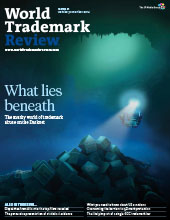-
News & Analysis
-
-
- Categories
- News & Analysis
- Legal Updates
- Long Reads
- Opinion
-
-
- Reports
- Data & Tools
-
Rankings
-
-
- WTR 1000
- Introduction
- All firms
- All individuals
-
- WTR 300
- Introduction
- Individual rankings
-
- Law firm leaders
- EUIPO Filing Elite
- The Global IP Awards
- WTR Global Leaders
-
- WTR Analytics
- WTR 1000 Analytics
-
-
-
Insight
-
-
- Insight
- Guides
- Reviews
- Market Insight
-
-
-
Events
-
-
- Events
- WTR Events
- Diary
-
-
-
- Login | Register

![]()
WTR 51
Shining a light on the Darknet
The Darknet is growing at a phenomenal pace. World Trademark Review dives into the murky depths to investigate the risks for brand owners.
Download
Features
From fees to the future
World Trademark Review presents its annual focus on the Office for Harmonisation in the Internal Market, polling users to gauge sentiment on its performance, assessing the impact of upcoming legislative changes and presenting updates direct from Alicante.
Time to shop around
In this article, private practice trademark counsel from 19 jurisdictions provide a general overview of the performance of their countries’ Community trademark courts.
The results are in on the ITC
The US International Trade Commission is a powerful and cost-effective weapon in the ongoing brand protection war, but remains underused.
The Convergence Programme in focus
The Convergence Programme links OHIM with national offices and user associations in an effort to find common ground in areas where IP offices have different practices.
Using numbers to win your case
Trademark cases can stand or fall on survey data that demonstrates the likelihood of confusion and actual confusion – the crucial issue is not just what type of data is collected, but how it is presented.
Traditional marks in a design world
Designs are becoming more crucial to manufacturers of consumer goods – distinctive design can not only result in aesthetically pleasing products, but also help to indicate the products’ origin. But could or should designs ever replace trademarks?
The Enforcement Database: an overview
The Enforcement Database is designed to provide a secure channel for businesses to exchange information with enforcement officials.
Challenges with 3D marks
Registrations for 3D marks are extremely attractive to rights holders – so much so that the European Court of Justice is continually adopting a stricter interpretation of the absolute grounds for refusal.
New GCC trademark law sparks change across the region
The Gulf Cooperation Council States Trademark Law came one step closer to reality when it was approved by the Cabinet of Ministers in Saudi Arabia. While a single trademark law for the region is positive news, it will mean big changes for each state.
Doing battle on and off the pitch
A review of IP disputes in Brazil during the FIFA World Cup and the lessons learnt.
Implications of US sanctions for rights holders
The United States maintains various economic sanctions around the world, which can directly affect rights holders. Rights holders may also be affected when they do business with Arab League countries that maintain the boycott against Israel.
Columns
The first years of Brazil’s SACI-Adm
SACI-Adm, the administrative proceeding for the resolution of conflicts involving ‘.br’ domain names, has seen increasing levels of use since its launch in 2010, suggesting that it can provide swift and efficient solutions to IP infringements.
It's officially time for a change to Canada's official marks regime
A new bill sets out proposals to overhaul Canada’s official marks regime. While the bill itself is unlikely to become law, there is a consensus that the official marks regime is in need of significant reform.
Quotes
Trademark-related quotes, opinions and observations from around the globe.
Country correspondent
Italy: One way or another
Multiple avenues are available to rights holders to protect their brands online.
United Kingdom: Now is the time for review
The online domain expansion raises a number of issues for UK rights holders.
Canada: Navigating the Canadian domain name landscape
Non-Canadian entities operating in or planning to enter the Canadian market would be well advised to consider acquiring a ‘.ca’ domain name sooner rather than later.
China: The electronic trademark
The view that domain names effectively function as ‘electronic trademarks’ is becoming increasingly prevalent, but in some respects infringement of domains can be more harmful.
United States: A strategy in five easy pieces
A number of key decisions need to be taken when developing an action plan for policing marks in the new gTLD space.
India: Taking a balanced approach
Faced with the new gTLD roll-out, a number of strategies are available to rights holders in both existing and new top-level domains.
Middle East: ‘.شبكة’ (‘.shabaka’) – a new gTLD in Arabic
Strategies for brand owners in anticipation of the new Arab language top-level domain '.شبكة' (‘.shabaka’).
Mexico: Strategies beyond registration
For those who have fallen victim to cybersquatting, there are options available to recover the desired domain name.
Poland: The case for specialised arbitration
Arbitration proceedings can be an attractive way of resolving domain name disputes.
News
Unlock unlimited access to all WTR content